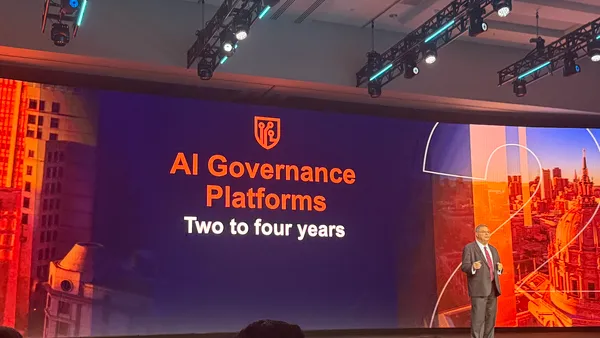At Zurich Insurance Group, adding customers to the life insurance client funnel can start with a simple selfie.
To make customers more aware of life and critical illness insurance, the company came up with a platform called FaceQuote, capable of leveraging artificial intelligence for automated life insurance quotes.
A user snaps a selfie and uploads it to the app. Then, an algorithm analyzes the photo to approximate a customer's age, and provides an estimate of what life insurance would cost them.
Instead of writing code to whip up the app, the team in charge of FaceQuote — which processes 63,000 selfies a year — relied on Mendix, the provider of what's called a low-code platform: a software development system that allows non-coders to build applications.
In the low-code market, players like Mendix, Appian, Zoho, OutSystems and others sell companies the ability to build software using alternative tools — like graphic interfaces — and more collaborative processes, as industries strive to compete.
But what gives software development platform the "low-code" distinction? According to John Rymer, analyst with Forrester Research, there are two key characteristics:
- Platforms that provide "declarative development tools and techniques" to build software instead of the traditional method of writing code. Though these methods vary, most often apps are built using visual tools, dragging and dropping the app's components onto a canvas.
-
Another key factor is the way vendors provide their solution to customers. The predominant model within the low-code space allows customers to initially adopt the platform at a lower cost, which will then go up as usage increases and more applications are built.
Across industries eager to modernize, low-code platforms promises access to quick product iteration and the alignment of business and tech priorities at talent-crunched companies.
Speed, competition drive adoption
Since Forrester coined the term in 2014, the popularity of low-code platforms has risen steadily.
Half of developers say they've either adopted or plan to adopt a low-code platform as part of their workflow, according to Forrester research.
What lures developers and IT managers to the technology is the ability to quickly launch and build new products in a collaborative way, said Nick Ford, chief technology evangelist at Mendix, in an interview with CIO Dive.
Where business users and technologists speak different languages, low-code gives them common ground to work together.
"It's really about collaboration, participation and a rapid, iterative process," Ford said.
For Mike Hughes, senior director of product marketing at low-code platform maker OutSystems, awareness of low-code has increased significantly over the past years. Clients are relying on the technology to fend off the competition, with business or product-savvy employees leading product iteration.
"If you're a retailer in Europe and Amazon Fresh pops-up, that's a threat," said Hughes. "Nobody's safe, so organizations are looking for ways to compete and catch up. We see low-code as a way to level the playing field."
Challenges of low-code
No system is without its flaws. In the case of low-code platforms, users can face challenges of scale, while companies must grapple with the possibility of vendor-lock in.
While some of the larger players in the low-code space can point to large application deployments — mission-critical products with thousands of global users — not all the companies offering low-code solutions are equipped to support scale, Rymer said.
"Like any product, it has its strengths and weaknesses," he said.
Companies adopting low-code are concerned with locking themselves in, as many low-code products feature proprietary content, which can make migration difficult if a vendor raises prices.
To reassure its client base, Mendix moved to an open-source model, offering customers documentation to migrate their platforms into the framework of their choice. It's also cloud agnostic.
The next era of low-code
The concept of "citizen coders" or "citizen developers" (non-technical staffers who can build software applications) will likely be bolstered amid the tightening labor market.
Users of OutSystem's platform currently run the gamut from biologists to business analysts who use the system instead of spreadsheets to bring efficiency to their work, Hughes said.
"There aren't enough developers to write the software companies need. Some of the work has to be delegated to business people," Rymer said. "There's no other way to get it done."
With automation poised to reshape the way industries see themselves, tools like these could eventually become mission-critical to sustain the pace of innovation.
"We don't have a choice, we have to recruit these people, but they have to have enough support so they can do the work and get help in the areas they need," Rymer said.
Correction: A previous version of this article misspelled Mendix and incorrectly stated that OutSystems moved to an open source model. Mendix moved to an open source model.














